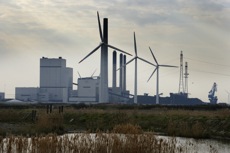Vattenfall’s Board has approved a plan to rebuild the power plant facilities in Denmark in order to use large quantities of biomass fuel instead of coal.
 Nordjylland Power Station. Nordjylland Power Station.Photo: Vattenfall |
The plan, which Vattenfall’s engineers have decided to call MaxBio, will replace up to 724,000 tons of coal per year, starting in 2018. As a result, it will prevent at least 1.5 million tons of carbon dioxide from being released into the atmosphere. That corresponds to a 27 percent decrease.
MaxBio will make a significant contribution to Vattenfall’s goal of making its energy production in the Nordic region carbon neutral by the year 2030. “Our goal is to turn electricity into an entirely clean product that customers can consume with a good conscience, given the concerns that they have about global warming. The entire Vattenfall Group is fully engaged in changing our power plants and production methods such that we can meet the expectations that world has on us to provide clean, environmentally friendly energy,” says Hans von Uthmann, Vattenfall’s Vice President and Head of Vattenfall Norden. “Of course, this is not a task that can be achieved overnight. But we have concrete plans to decrease carbon dioxide emissions each year. In the Nordic region alone, we will invest more than 60 billion Danish crowns (approx. € 8 billion) until the year 2016 in order to achieve this goal. The new MaxBio plan comprises investments in excess of 5 billion Danish crowns (approx. € 670 Mio.),” says Hans von Uthmann.
Replacing coal with biomass is a quick and effective method of reducing carbon dioxide emissions. Once Vattenfall’s biomass program has been implemented, all units at the company’s three large Danish heat plants, Amagerverket, Fynsverket and Nordjyllandsverket, will be biomass-fueled. This will either be at 100 percent, or in combination with coal. During the first phase, wood and straw will be used. But, other types of biomass fuel may also be considered. “We recognize the advantages of using straw, wood pellets and chips. We also hope that there will be harmonization on the legal side, such that more types of biomass fuel will become available. At present, just 15 to 17 materials have been defined as biomass fuel in the biofuel regulations. All other types of biomass are defined as waste,” says Environmental Manager, Jørgen Nielsen.
Source
Vattenfall, press release, 2009-02-09.
Supplier
Share
Renewable Carbon News – Daily Newsletter
Subscribe to our daily email newsletter – the world's leading newsletter on renewable materials and chemicals










